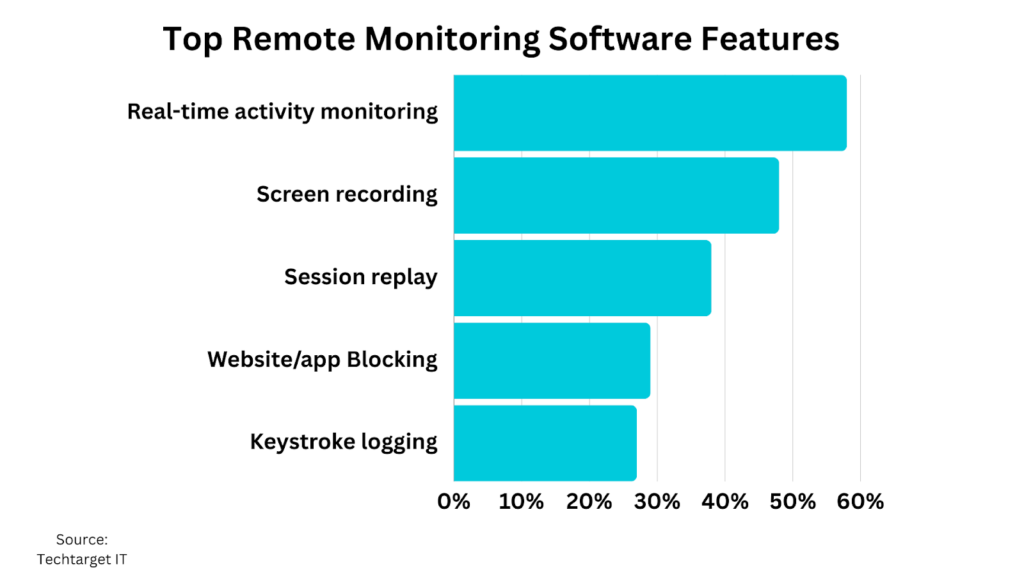Mastering Remote Monitoring: Best Practices for Empowering Your Organization

Many organizations now see implementing remote monitoring software as a priority. It can boost productivity and security. As the remote workforce expands, so does the market for remote monitoring software, with projected significant growth in the coming years. However, strategic implementation is key to fully leveraging these tools within your organization. It will grow at a CAGR of 5.6%. Utilizing these tools is essential. As leading providers of remote monitoring software, strategic implementation is key to fully realizing the potential of these powerful technologies within your organization. This article outlines best practices for using remote monitoring software. They will maximize its value for your business.
Assessing Your Organization’s Needs
The first step is identifying your key objectives for adopting remote monitoring. What are the specific pain points you want to alleviate?
Common goals include the following:
- Improving productivity by monitoring employee activities
- Enhancing security by restricting unauthorized access
- Streamlining operations through automated tracking and alerts
Identifying Key Objectives
Ensure that your remote monitoring goals align with your overall business strategies. For example, tracking sales reps’ talks with clients can reveal insights. These insights can be used to improve lead conversion rates.
Stakeholder Engagement
Involve all stakeholders early to understand diverse needs and expectations. Technology, Security, Legal, HR, Finance, and end-users should define monitoring requirements collaboratively.
Legal and Privacy Considerations
Navigate the legal landscape cautiously to ensure privacy compliance. Seek counsel on monitoring policies and obtain user consent where applicable. Transparency is key.
Choosing the Right Remote Monitoring Software
The market size for remote monitoring software is projected to reach multi-million USD. Due to the rise in remote work, the options for monitoring software have expanded exponentially. Carefully evaluate leading solutions against your defined requirements.
| Software | Key Features | Mobile App | Ease of Use |
| Acme Monitor | Activity monitoring, screenshot capture, session recording | Yes | Intuitive dashboard |
| TrackPro | Website/app tracking, geofencing, access controls | Yes | Steep learning curve |
| InsightsRM | Real-time monitoring, automated alerts, custom reporting | No | Simple, clean interface |
| Vision360 | Keystroke logging, productivity metrics, advanced analytics | Yes | Moderate onboarding needed |
Feature Analysis
- Determine must-have features like activity monitoring, screenshots, URL/app tracking, etc.
- Prioritise nice-to-have capabilities like session recording, keystroke logging, file transfers, etc.
- Compare solutions against weighted criteria to select the best fit.
Scalability and Flexibility
- Evaluate the current user base and projected growth over the next 3-5 years.
- Assess if solutions provide easy scalability through their pricing models.
- Determine if advanced features can be added on demand.
Security Measures
- Review encryption protocols like TLS 1.2 and data security certifications.
- Assess role-based access controls and remote lock/wipe of devices.
- Confirm monitoring data and actions are logged for auditing.
User Experience
- Check for a responsive, intuitive dashboard accessible across devices.
- Review educational resources like onboarding guides, demos, and contextual help.
- Assess the ability to customise views, notifications, and settings for each user role.

Implementation Strategy
Develop a robust change management plan covering all aspects of rollout and ongoing support.
Phased Rollout vs Big Bang
- Pilot monitoring software with a smaller team to test integrations and workflows.
- Gradually expand to larger groups once processes are refined.
- Or, schedule a big bang rollout but have contingency plans and support resources.
Training and Support
- Create onboarding guides explaining software capabilities and boundaries.
- Conduct virtual training sessions with mock monitoring scenarios.
- Have 24/7 help resources for ongoing assistance.
Integration with Existing Systems
- Identify all systems that need data from monitoring software.
- Develop APIs and connectors to enable data flows.
- Test integrations and data transfer thoroughly pre-launch.
Monitoring and Evaluation
Continuous oversight ensures maximum value from your investment in remote monitoring.
Setting KPIs
- Define quantitative targets for productivity, security, and efficiency.
- Set service-level KPIs for uptime, response times, issue resolution, etc.
- Establish milestone targets for adoption rates, and policy compliance.
Regular Audits
- Audit software performance – is it meeting defined KPIs?
- Audit usage data – which features are most/least used?
- Audit user feedback – are adjustments needed?
Feedback Loops
- Conduct periodic surveys to measure user satisfaction.
- Analyse help desk tickets to identify recurring issues or concerns.
- Track adoption metrics and address hurdles immediately.
Sustaining Engagement and Productivity
The market is expected to reach $32.3 billion by 2027. So, getting employee buy-in is essential.
Cultivating a Culture of Transparency
Balance monitoring with open communication and transparency. Employees who understand the rationale are more receptive.
Enhancing Communication
Leverage monitoring tools to identify barriers and improve collaboration. This builds trust and unity.
Recognition and Rewards
Acknowledge achievements, compliance, and feedback. Positive reinforcement motivates engagement.
The Power of Scripting and Automation in RMM
Strong scripting and automation are key RMM capabilities. They enable better efficiency, lower costs, and improved security.
Automated Remediations
RMM tools allow the creation of scripts that automate fixing common IT issues like:
- Restarting unresponsive services
- Running diagnostics and repairs
- Installing missing patches
- Clearing disk space
This saves significant time compared to manual troubleshooting and remediation.
Remote Monitoring
RMM scripts continually check system health metrics like:
- CPU/memory usage
- Available storage
- Service status
- Hardware performance
Alerts are generated for any thresholds exceeded. This enables proactive optimization.
Patch Management
Scripts auto-update applications and systems with the latest patches to prevent vulnerabilities. Key benefits include:
- Reduced security risks
- Fewer system crashes or freeze-ups
- Streamlined regulatory compliance
Enhanced Productivity
Automated remediation, remote monitoring, and patch management are powered by scripting. They let IT teams focus on strategy, not repetitive tasks. This maximizes their productivity.
In summary, using RMM scripting and automation has big benefits. It helps with performance, security, and productivity. It empowers lean IT teams to effectively support much larger infrastructures.
FAQs
How can organizations ensure employee privacy while implementing remote monitoring?
Strive for minimal intrusive monitoring required to meet defined needs. Anonymize employee data and enforce access controls. Communicate policies and obtain informed consent.
What are the common challenges in implementing remote monitoring software and how can they be addressed?
Resistance to change is expected. Involve stakeholders early and implement change management plans. Technical issues arise but can be mitigated with phased rollouts and training. Integration with legacy systems can also be challenging but APIs and expert support help.
How often should an organization review its remote monitoring policies and software efficiency?
Conduct quarterly reviews to start, then optimize frequency based on implementation complexity. Changes in technology, regulations, and company strategy may warrant more frequent reviews.
Conclusion
Remote monitoring software delivers immense value but ineffective implementation carries risks. Follow these best practices to improve monitoring for your organization’s needs. Do this while prioritizing security, transparency, and engagement. With a thoughtful approach, you can leverage these tools to build a more empowered and productive workforce.
Call to Action
For help, download the free guide. It will help you create the best remote monitoring strategy for your organisation.




